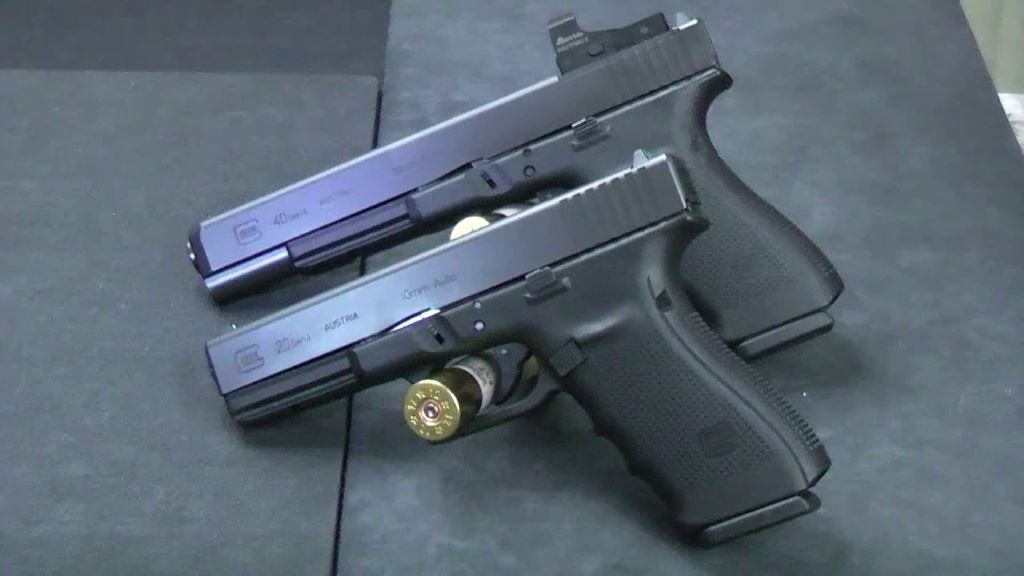When it comes to handguns, Glock is a name that needs no introduction. Known for their reliability, durability, and simplicity, Glock pistols have earned a loyal following among shooters of all levels. Among their extensive lineup, the Glock 20 and Glock 40 stand out as two formidable options chambered in the powerful 10mm Auto caliber. In this comprehensive comparison, we’ll take a close look at Glock 20 vs Glock 40, exploring their specifications, differences, and what makes each of them unique.
Glock 20 vs Glock 40 Overview
Before diving into the details, let’s get acquainted with the protagonists of this comparison – the Glock 20 and Glock 40. Here is a chart:
| Feature | Glock 20 | Glock 40 |
| Caliber | 10mm Auto | 10mm Auto |
| Barrel Length | 4.6 inches | 6.02 inches |
| Overall Length | 8.07 inches | 9.49 inches |
| Height | 5.51 inches | 5.79 inches |
| Width | 1.26 inches | 1.30 inches |
| Weight | 29.30 ounces | 32.20 ounces |
| Magazine Capacity | 15 rounds | 15 rounds |
| Sights | Polymer fixed | Polymer fixed |
| Action | Striker-fired | Striker-fired |
| Safety | Safe Action System | Safe Action System |
| Finish | Tenifer | Tenifer |
Caliber and Power
Both the Glock 20 and Glock 40 share the same caliber: the potent 10mm Auto. This caliber is known for its substantial stopping power, making it a favorite among those who require a pistol for self-defense or hunting. However, there’s more to it than just the caliber.
The Glock 20 features a 4.6-inch barrel, which strikes a balance between portability and accuracy. It’s ideal for concealed carry and close-quarters situations where maneuverability is crucial.
On the other hand, the Glock 40 boasts a longer 6.02-inch barrel. This extended barrel length translates to higher muzzle velocity and improved accuracy at longer distances. If you’re looking for a pistol optimized for hunting or target shooting, the Glock 40’s longer barrel might be your choice.
Size Matters: Dimensions and Weight
When it comes to firearms, size matters. The Glock 20 and Glock 40 differ in several key dimensions that can significantly impact their usability and suitability for different purposes.
The Glock 20 measures 8.07 inches in overall length, 5.51 inches in height, and 1.26 inches in width. It’s a compact yet powerful option, suitable for concealed carry or as a backup weapon for law enforcement officers.
On the other hand, the Glock 40 is noticeably larger, measuring 9.49 inches in overall length, 5.79 inches in height, and 1.30 inches in width. This size increase is primarily due to its longer barrel, which, as mentioned earlier, enhances accuracy at longer ranges. However, it also makes the Glock 40 less concealable and more suited for open carry or holster use.
Weighty Matters
The weight of a firearm can affect its comfort during extended use and its suitability for various applications. In this aspect, the Glock 20 weighs in at 29.30 ounces, while the Glock 40 is slightly heavier at 32.20 ounces.
While the weight difference between the two pistols isn’t dramatic, it can be noticeable, especially when carrying the pistol for extended periods. Keep in mind that the added weight of the Glock 40 contributes to its enhanced stability and recoil control, which can be beneficial when firing high-powered 10mm Auto rounds.
Magazine Capacity
Both the Glock 20 and Glock 40 come equipped with magazines capable of holding 15 rounds of 10mm Auto ammunition. This standard capacity is generous and provides ample firepower in a self-defense or tactical situation.
Having the same magazine capacity means you won’t have to compromise on the number of rounds you carry, regardless of whether you choose the Glock 20 or Glock 40.
Sights and Accuracy
When it comes to aiming and accuracy, both pistols feature polymer fixed sights. These sights are rugged and low-maintenance, which aligns with Glock’s overall design philosophy. However, some shooters prefer to upgrade to aftermarket sights for improved precision.
While both pistols offer adequate accuracy, the Glock 40’s longer barrel provides a potential advantage for shooters looking to make precise shots at greater distances. It allows for a better sight radius, reducing the chances of missing your target.
Action and Safety
Both the Glock 20 and Glock 40 utilize Glock’s renowned Safe Action System, which includes multiple internal safeties to prevent accidental discharges. This system is known for its reliability and safety, making it a trusted choice for law enforcement and civilian users alike.
Both pistols also feature a striker-fired action, which is known for its consistent trigger pull and reliability. The trigger pull weight is similar on both models, ensuring a consistent shooting experience.
Finish: Tenifer Treatment
One area where the Glock 20 and Glock 40 share a common feature is their finish. Both pistols receive Glock’s Tenifer treatment, a corrosion-resistant and durable surface finish. This treatment helps protect the pistols from the rigors of daily use, making them suitable for various environments and weather conditions.
Choosing Between Glock 20 and Glock 40
Now that we’ve explored the key specifications and differences between the Glock 20 and Glock 40, let’s discuss the factors you should consider when choosing between these two 10mm Auto pistols.
1. Intended Use:
Your primary use for the pistol will greatly influence your choice. If you’re looking for a versatile option that can serve as a concealed carry firearm and a self-defense tool, the Glock 20’s compact size and reasonable barrel length make it a strong candidate.
On the other hand, if you’re an avid hunter or target shooter seeking improved accuracy at longer distances, the Glock 40’s longer barrel and increased weight may be more appealing.
2. Concealability:
If you plan to carry your pistol concealed, the Glock 20’s smaller dimensions and lower weight make it a more practical choice. Its shorter barrel also aids in concealing the firearm under clothing.
Conversely, the Glock 40’s larger size and longer barrel make it less suitable for concealed carry. It’s better suited for open carry or use in a holster.
3. Recoil Control:
The 10mm Auto cartridge generates substantial recoil. If recoil control is a concern for you, the Glock 40’s added weight can help mitigate the recoil, making it easier to manage during rapid fire or follow-up shots.
4. Distance Shooting:
If you plan to use your pistol for target shooting or hunting at longer distances, the Glock 40’s longer barrel provides a distinct advantage in terms of accuracy and muzzle velocity.
5. Overall Comfort:
Consider how comfortable each pistol feels in your hand. Visit a local firearms store or shooting range to get a feel for both models. Your comfort and confidence in handling the pistol can significantly impact your shooting performance.
Frequently Asked Questions (FAQs)
- Are the Glock 20 and Glock 40 suitable for concealed carry?
- The Glock 20 is more suitable for concealed carry due to its smaller dimensions and lower weight. The Glock 40 is better suited for open carry or holster use.
- Is there a significant difference in recoil between the Glock 20 and Glock 40?
- The Glock 40’s added weight can help mitigate recoil, making it more manageable during rapid fire or follow-up shots compared to the Glock 20.
- Can I use both pistols for self-defense?
- Yes, both the Glock 20 and Glock 40 are suitable for self-defense, given their 10mm Auto caliber and 15-round magazine capacity. Your choice should be based on factors like concealability and recoil control.
- Which pistol is better for hunting?
- The Glock 40 is better suited for hunting due to its longer barrel, which enhances accuracy and muzzle velocity for longer-distance shots.
- Are there aftermarket sights available for the Glock 20 and Glock 40?
- Yes, both pistols have a wide range of aftermarket sight options available for those looking to upgrade their sights for improved precision.
Conclusion
In the comparison of Glock 20 vs Glock 40, the Glock 20 and Glock 40 both shine with their reliability and firepower. Your intended use should drive your choice between these two pistols, whether it’s for concealed carry, hunting, or target shooting. When comparing the Glock 19 Gen 3 to the Gen 5, it’s crucial to consider factors like size, recoil control, and comfort, but rest assured that both models share the renowned Safe Action System and Tenifer finish, ensuring a dependable and durable firearm, no matter your choice. Ultimately, the choice between the Glock 20 and Glock 40 comes down to your specific needs and preferences, but you can’t go wrong with either option.
Tags: 10mm ammo, 10mm auto, 10mm pistol, firearm, firearms selection, glock, glock 20, glock 40, glock comparison, glock model comparison., gun comparison, handgun, pistol, self-defense, shooting sports





Leave a Reply